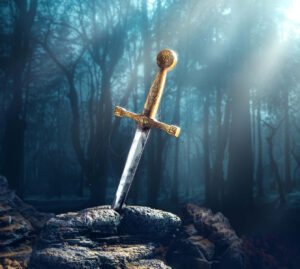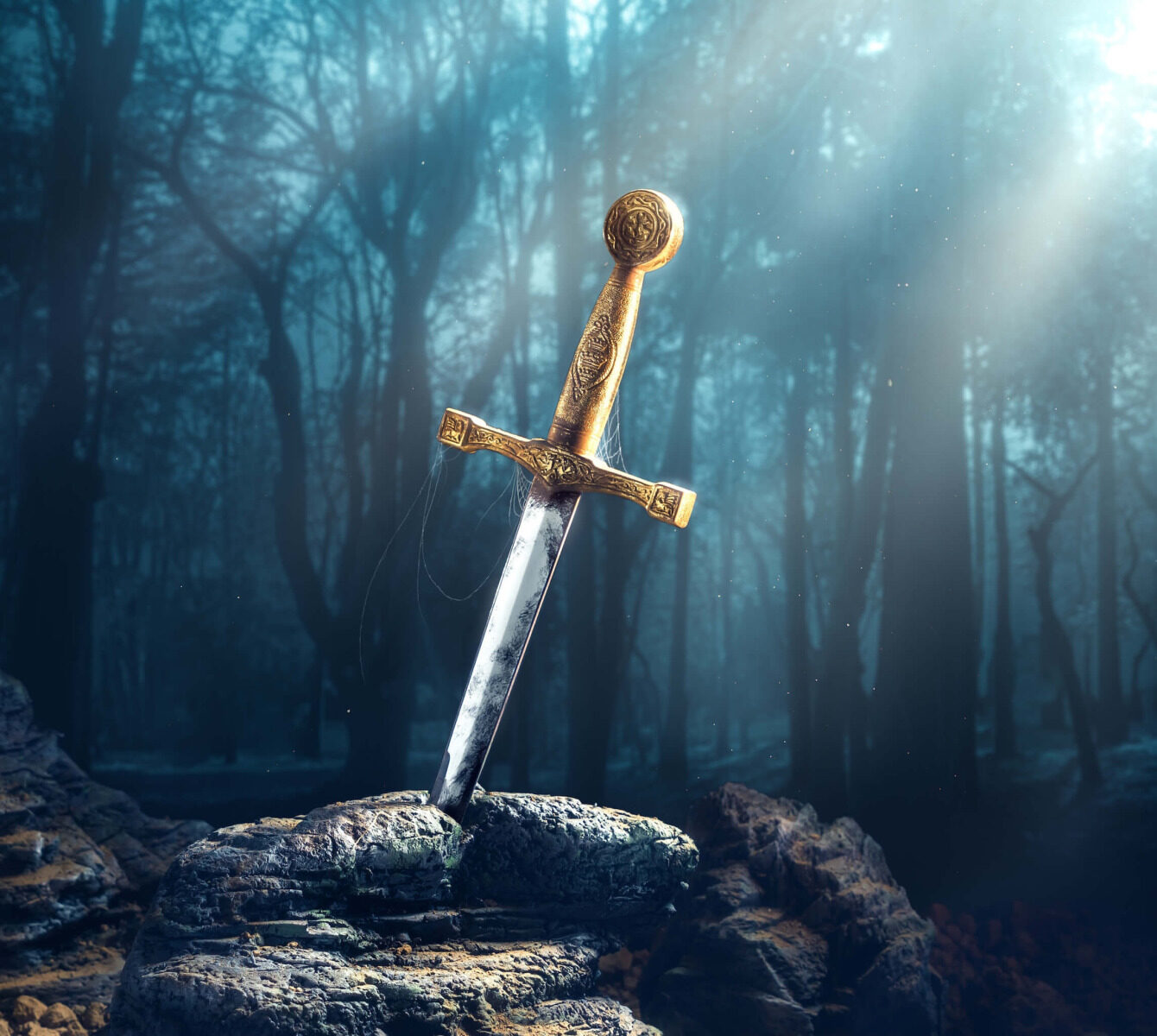Famous Swords: Blades that Shaped History
Throughout the annals of history, swords have transcended their role as mere weapons, becoming symbols of power, honor, and legacy. From the mythical blades of ancient legends to the revered relics of medieval battles, famous swords have shaped the destinies of empires and inspired countless tales of valor. Each blade carries a unique story, reflecting the artistry of its craftsmanship, the significance of its owner, and the tumultuous events it witnessed. In this article, we journey through time to uncover the legendary swords that have etched their marks on history, exploring their origins, mythologies, and enduring impact on cultures around the world.

1. Excalibur
Excalibur, the fabled sword of King Arthur, stands as a monumental symbol of chivalry, honor, and divine right. Associated with Arthurian legend, this sword’s historical roots are both intriguing and enigmatic. While often depicted in various medieval and modern adaptations, historians debate whether Excalibur is based on a real weapon or purely a product of myth. No physical sword known as Excalibur has been definitively identified, leading scholars to suggest that the legend may have been inspired by actual medieval blades, possibly imbued with symbolic or ceremonial significance.
In Arthurian legend, Excalibur is described with remarkable features that elevate its status beyond mere weaponry. The sword is frequently illustrated with a jewel-encrusted hilt and a blade inscribed with magical runes or symbols, highlighting its supernatural qualities. This imagery conveys the sword’s divine endorsement and extraordinary power. The sword is central to two major Arthurian stories: in one version, Arthur draws it from a stone, proving his rightful claim to the throne, while in another, it is given to him by the Lady of the Lake, emphasizing the divine support for his reign.
The historical significance of Excalibur lies more in its symbolic role than in any tangible evidence. The sword embodies ideals of kingly virtue, divine right, and the epic heroism of Arthur’s rule. Its portrayal in literature and folklore illustrates the themes of destiny and divine favor, reinforcing the narrative of Arthur as the ideal king. Though no concrete historical evidence supports the existence of Excalibur as described, its impact on cultural and literary traditions is profound and enduring.
Excalibur’s influence extends beyond its mythological origins. The sword has inspired countless adaptations across various media, from medieval romances to contemporary fantasy. Its legend captures the imagination, reflecting the enduring allure of medieval chivalry and the timeless appeal of heroic narratives. Despite the lack of historical verification, Excalibur remains a powerful symbol of nobility and heroism, embodying the timeless ideals of virtue and leadership.
2. The Sword of St. Michael
The Sword of St. Michael is a celebrated ceremonial weapon associated with the archangel Michael, a central figure in Christian tradition known for his role as protector and warrior. This sword holds a prominent place in European history, symbolizing the divine favor and martial prowess attributed to the archangel. Throughout the medieval and Renaissance periods, it was used in important rituals and ceremonies, reinforcing its significance as a symbol of holy protection and authoritative power.
One of the most striking aspects of the Sword of St. Michael is its elaborate design, which reflects its ceremonial purpose. The sword’s hilt and blade are adorned with intricate religious iconography, such as crosses, angels, and inscriptions that underscore its sacred nature. The craftsmanship of the sword is meticulous, with ornate detailing that often includes precious metals and gemstones. This design not only enhances the sword’s aesthetic appeal but also signifies its role as a divine instrument rather than a practical weapon.
Historically, the Sword of St. Michael was employed in various ceremonial contexts, including the coronation of monarchs and the investiture of knights. Its presence in these rituals was intended to symbolize the divine protection and authority bestowed upon rulers and warriors by St. Michael. The sword represented the idea that the archangel’s guidance and protection were crucial for upholding justice and righteousness, thus bridging the earthly and the divine in the context of governance and knighthood.
The cultural impact of the Sword of St. Michael extends beyond its historical use. It remains a potent symbol of chivalric ideals and Christian values, reflecting the grandeur of medieval ceremonies and the enduring belief in divine intervention. The sword’s legacy continues to be celebrated in modern ceremonial practices and artistic representations, maintaining its status as an emblem of divine protection and noble virtue throughout history.
3. The Sword of Charlemagne
The Sword of Charlemagne, known as Joyeuse, is a legendary blade intimately connected with Charlemagne, the first Holy Roman Emperor. This sword is not only a symbol of historical significance but also a ceremonial artifact used in the coronation of French kings. Joyeuse’s storied past intertwines with Charlemagne’s legacy, representing the divine right of kings and the continuity of his rule through the French monarchy.
Joyeuse is renowned for its opulent decoration, which reflects its ceremonial importance. The sword is lavishly adorned with gold, jewels, and intricate designs that combine Christian symbolism with medieval artistry. Its hilt features elaborate carvings, including Christian crosses and other religious motifs, emphasizing its sacred and regal status. The blade itself is often depicted with ornate engravings and inlaid with precious materials, highlighting the sword’s role as a symbol of divine authority rather than a mere weapon.
Historically, Joyeuse played a pivotal role in French royal ceremonies, particularly in the coronation of monarchs. The sword’s use in these ceremonies was intended to signify the divine endorsement of the king’s rule and the continuation of Charlemagne’s legacy through the French royal line. By wielding Joyeuse, the newly crowned king was symbolically connected to Charlemagne’s reign, reinforcing the notion of divine right and the sanctity of the monarchy.
Beyond its historical and ceremonial roles, Joyeuse remains a potent symbol of the power and prestige of the French monarchy. The sword’s legacy endures in both historical records and cultural memory, representing the grandeur of medieval kingship and the divine sanction bestowed upon rulers. Today, Joyeuse continues to be celebrated as a national treasure, embodying the rich heritage and enduring symbolism of the French monarchy’s storied past.
4. The Ulfberht Swords
The Ulfberht swords are a celebrated collection of Viking-era weaponry, renowned for their exceptional quality and craftsmanship. Produced between the 9th and 11th centuries, these swords stand out as masterpieces of medieval metallurgy and blade-making. They represent a significant achievement in Viking weaponry, reflecting both advanced technological prowess and the importance of high-quality arms in Viking society.
A distinctive feature of Ulfberht swords is their marking, which prominently displays the inscription “ULFBERHT” on the blade. This mark signifies the high quality of the steel used in their production, distinguishing them from other contemporary swords. The advanced metallurgy involved in crafting these blades is evident in their superior hardness and durability compared to other swords of the era. Ulfberht swords often feature a cruciform hilt, designed to provide a balanced grip and enhance combat effectiveness. The blade is typically broad and double-edged, crafted to withstand the rigors of battle and deliver powerful strikes.
Historically, Ulfberht swords hold significant importance as symbols of technological innovation during the Viking Age. The superior steel used in these swords was achieved through advanced smelting techniques, which involved the use of crucible steel—a method that allowed for the creation of a stronger, more resilient blade. This technological advancement not only made the Ulfberht swords highly prized among Viking warriors but also contributed to their lasting legacy in the study of medieval weaponry.
Today, Ulfberht swords are regarded as exemplars of Viking craftsmanship and innovation. They provide valuable insights into the technological and artistic achievements of the Viking Age and continue to captivate historians and enthusiasts alike. The enduring legacy of these swords highlights their significance as both functional weapons and symbols of the sophisticated metalworking skills of the Vikings.
5. The Masamune Sword
The Masamune sword, crafted by the legendary Japanese swordsmith Goro Nyudo Masamune, stands as one of the most revered blades in the history of Japanese sword-making. Active during the late Kamakura period (13th to 14th centuries), Masamune is celebrated for creating some of the finest katanas ever forged. His swords are not only prized for their exceptional functional qualities but also for their artistic excellence, embodying the zenith of Japanese sword-making craftsmanship.
Masamune swords are renowned for their superb craftsmanship, which manifests in several distinctive features. One of the most notable characteristics is the blade’s exquisite balance and sharpness, achieved through meticulous forging and tempering techniques. Each sword typically showcases a beautiful hamon (temper line) that is the result of the differential hardening process. This hamon is not only aesthetically pleasing but also indicative of the sword’s durability and cutting ability. Additionally, Masamune swords often come with intricate fittings, including finely decorated tsuba (handguards), tsuka (handles), and fuchi (collars), which highlight the swordsmith’s artistry and attention to detail.
Historically, Masamune swords are highly prized by collectors and historians alike. They represent the peak of Japanese sword-making artistry and the culmination of centuries of evolving techniques and aesthetic ideals. The blades are often associated with samurai warriors and the cultural heritage of feudal Japan, reflecting the high status of their owners and the significance of the swords in martial traditions. The exceptional quality of Masamune swords has earned them a place in the annals of Japanese history as symbols of both martial prowess and artistic excellence.
The legacy of Masamune swords continues to captivate the world today. These blades are not only celebrated for their functional attributes but also for their role in Japanese cultural history. They are regarded as masterpieces of craftsmanship and are treasured as cultural artifacts that embody the spirit of the samurai and the artistic achievements of medieval Japan. The enduring fascination with Masamune swords underscores their status as iconic symbols of the height of Japanese sword-making artistry.
6. The Cortés Sword
The Cortés Sword, frequently associated with the Spanish conquistador Hernán Cortés, is a significant artifact from the Age of Discovery. This sword played a prominent role during the Spanish conquest of the Aztec Empire in the early 16th century. It stands as a powerful symbol of the era’s exploration and conquest, representing both the military prowess of the Spanish conquistadors and the dramatic cultural exchanges that defined the period.
Notable for its elaborate design, the Cortés Sword exemplifies the blend of European craftsmanship and the evolving weaponry of the Renaissance era. The sword’s hilt is often richly decorated with intricate engravings, ornate pommels, and detailed crossguards, reflecting the transition from medieval to Renaissance styles. The blade itself is typically broad and double-edged, designed for effective combat in both mounted and infantry engagements. The ornate nature of the sword not only signifies its ceremonial importance but also highlights the wealth and status of its owner.
Historically, the Cortés Sword is emblematic of the Spanish conquest of the Americas and the ensuing clash of cultures. Hernán Cortés, leading the Spanish forces, used this sword during pivotal moments of the conquest, including key battles and negotiations with the Aztec rulers. The sword’s presence in these historical events underscores the broader narrative of European expansion and the dramatic impacts of such encounters on indigenous civilizations. The weapon symbolizes the broader themes of power, imperialism, and cultural transformation that characterized the Age of Exploration.
Today, the Cortés Sword remains a potent symbol of both the era’s military history and the complex cultural interactions of the time. It serves as a reminder of the technological and artistic achievements of the Renaissance, as well as the profound and often tumultuous consequences of European exploration and conquest. The sword’s legacy continues to be studied and admired, offering insights into a pivotal period in world history and the cultural exchanges that shaped it.
7. The Scottish Claymore
The Scottish Claymore is a formidable two-handed sword that gained iconic status during the late medieval period. Characterized by its impressive size and robust design, the Claymore became a defining weapon of Scottish warfare and a symbol of national pride. Its prominent role in the battles for Scottish independence cemented its place in history and folklore as a representation of valor and resistance against oppression.
One of the most distinctive features of the Claymore is its cross-shaped hilt, which provides a secure grip and facilitates powerful strikes. The sword’s wide, double-edged blade is designed for both slashing and thrusting, making it effective in various combat scenarios. The hilt’s design allows for the use of both hands, giving the wielder greater control and force in battle. This design not only maximized the Claymore’s effectiveness in close-quarters combat but also reflected the evolving nature of medieval weaponry as combat strategies advanced.
Historically, the Claymore is closely associated with prominent Scottish figures such as William Wallace and Robert the Bruce, who used the sword in their campaigns against English forces. The sword’s association with these legendary leaders underscores its significance in the struggle for Scottish independence. The Claymore became emblematic of Scottish resistance and courage, representing the fierce determination of the Scots to defend their homeland and assert their autonomy.
Today, the Scottish Claymore continues to be a powerful symbol of Scottish national identity. It embodies the spirit of independence and resilience that defined the Scottish struggle for freedom. The sword’s legacy endures in Scottish cultural heritage, serving as a reminder of the country’s rich martial history and its ongoing pride in its historical battles and heroes. As both a weapon and a cultural icon, the Claymore remains a lasting symbol of Scottish strength and unity.
8. The Sword of D’Artagnan
The Sword of D’Artagnan, though famously associated with the fictional hero of Alexandre Dumas’s The Three Musketeers, also holds historical interest due to its connection with the real-life figure Charles de Batz-Castelmore d’Armanac, known as the Comte de D’Artagnan. While Dumas’s character is a product of literary imagination, the historical D’Artagnan was a prominent figure in 17th-century France, serving as a captain of the Musketeers of the Guard. His real-life sword, while not as widely documented as its fictional counterpart, represents the era’s martial and cultural nuances.
Historical swords from D’Artagnan’s time were often elaborately crafted, combining functionality with ornamental design. These swords typically featured intricately decorated hilts, including ornate guards and pommels, and were sometimes inlaid with precious metals or gemstones. The blade itself was designed for both combat and ceremonial purposes, reflecting the status and wealth of its owner. The combination of practical use and elaborate decoration made these swords symbols of prestige and martial prowess.
The Sword of D’Artagnan, in both its fictional and historical contexts, symbolizes the romanticized ideal of the musketeer era. Dumas’s portrayal of D’Artagnan and his fellow musketeers as gallant and daring figures has become a defining representation of 17th-century French chivalry and adventure. This romanticized image, while based on the real-life context of D’Artagnan’s service in the Musketeers, adds a layer of literary allure to the historical reality of his era.
In a broader historical context, the sword reflects the martial culture and social structures of 17th-century France. It serves as a reminder of the era’s complex interplay between nobility, military service, and cultural representation. Today, the sword of D’Artagnan continues to capture the imagination of both historians and enthusiasts, embodying the blend of historical fact and literary fantasy that has made the musketeer legend enduringly popular.
Conclusion,
As we sheath the blades of our historical exploration, it’s clear that these iconic swords are more than just relics of warfare. They embody the spirit of their eras, the artistry of their creators, and the indomitable will of their wielders. From the mythical Excalibur to the famed Katana, each sword carries a rich tapestry of stories, legends, and historical significance. These blades have not only shaped the course of battles but also inspired tales of heroism and honor that continue to captivate our imaginations. By delving into the history of these renowned swords, we gain a deeper appreciation for the enduring impact they have had on culture, symbolizing the timeless quest for greatness and the unyielding pursuit of legacy.




